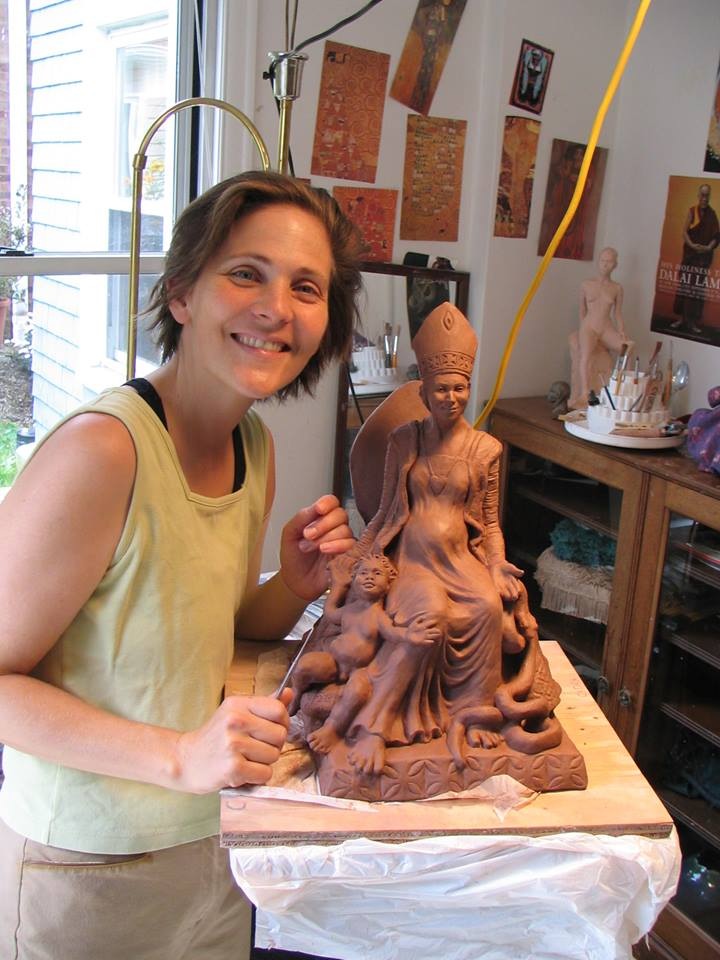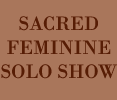|
Cydra R. Vaux (1962-2013)
Cydra Vaux was born in 1962 in Utah, lived in Minneapolis until age 5, then California from age 5-7, before she and her family moved to Pittsburgh, where she resided through high school. Cydra attended Seton Hill University, where she received a B.A. in Theater in 1985. In 1995 Cydra returned to Seton Hill, where she completed work for her Art Education Certification. From 2000-2013, Cydra worked as an art teacher at Shadyside Academy Junior School.
Beginning in 1998, Cydra refined her focus to the female terracotta figure. Her work is firmly rooted in traditional and feminist art history. Often, she worked spontaneously from her subconscious and dreams, invoking surrealist traditions. Cydra explored the relationships among archetypal images from different cultures, including the mandorla, swastika, heart, and serpent. These symbols form an amalgam reflecting a modern feminist worldview that unites dissimilar cultural traditions, religious traditions, and gender roles.
Cydra reimagines and reclaims the lives of historical and mythological women by reassigning meaning through a feminist lens. At times, the women in her sculptures project a reserved distance, a feeling of coolness that speaks to the veracity of their strength and self-containment. In this way the mother archetype is expanded to favor a more comprehensive view of woman.
Cydra wrote this Artist Statement before 2010, when her sculptures shifted to depicting her experience confronting her cancer recurrence:
A favorite photograph of mine is Judy Chicago and Miriam Shapiro sitting on the steps in front of Womanhouse in 1972. At that time, I was too young to join one of the most profound feminist dialogues in my life. However, every time I go into my studio I am forwarding that revolution. Looking back through history, I see time and time again how art is a powerful agent for reform and holds before us our ideals. I hope my art will continue to challenge us to cultivate compassion and equality between the sexes.

My earliest remembrance of using my art to further my gender's liberation came at the church of my youth -- overseen by a distant white bearded god who neither desired a companion nor needed one to single-handily father the whole universe in his own image. Even at a young age I felt this inequity to my core. My response: to cut out the construction paper words “God loves you, pray to Her”, and staple it to a bulletin board in the main entry of the church. My brazen words proclaimed their truth to the painted cinder block hallway for the briefest period before a pack of laughing boys tore it down.
My adult years find me continuing the work of that grade school girl; creating for myself the presence of the divine feminine. Through my work, I pull forth from my psyche different attributes that I want to strengthen in myself, and ones that I want to affirm and have mirrored back to me. My art also provides a vehicle for me to investigate personal issues in my own life and to challenge patriarchal belief structures.
My work is often Utopian, imagining a world where women and men validate each other, cultivating compassion and equality between the sexes. I need to imagine a world of transcendence and wholeness. Because much of women’s history has been absorbed into patriarchal frameworks, I create feminist sculptures that reclaim and revision women’s symbols, history, and mythology.
At times I have instead considered narrating women's struggles, and to reveal the pain and anger of those struggles. However, I need to know that I can also imagine a world of love, equality, and justice. I have needed to create for myself what I am unable to find in my life, or what I need to have reinforced. Therefore, my work focuses on the promise of nonviolence by creating wholeness in my work.
There have been a host of other painful issues that have touched my heart that I have needed to focus on, through the lens of a solution. I need to believe that a just answer exists. This is not to say that pain and tension are not to be found in some of my work, whether I have allowed it to coexist, or whether it has crept in on its own. To this end the hallmark of my work has been order, symmetry, harmony, and beauty.
The writing that accompanies my visual work is an integral part of the work, and not an afterthought. These written and visual components are a metaphor for a symbiotic relationship between the masculine and feminine. The written word (masculine, left brained) is married to the figurative image (feminine, right brained) to form a complete whole, or yin yang.
Travels to India, Egypt, Brazil, and the Southwest also informed Cydra’s sculptures. Through exposure to a myriad of religious, spiritual and humanist traditions, she explored tension and harmony between the secular and the divine. Making sculptures that are multi-sided, Cydra used sculpture as a metaphor for multiple viewpoints. Seemingly fixed images morph among different vantage points. The three dimensional sculpture, with its unlimited number of views, becomes an allegory for mercurial thoughts and multifaceted perspectives. This tension between seemingly opposite sides fits well with her exploration of the yin-yang as it is expressed through female/male, secular/divine, life/death, image/word. Symmetry and beauty inform much of her work, holding out hope for Utopian ideals.
Beginning in 2010, Cydra’s sculptures shifted to depicting her battle with breast cancer metastasized to her liver.
This work is deeply personal, while having a universal reach. Death and the Divine are figures which struggle to resolve the irresolvable. These pieces depict how Cydra courageously navigated the challenges imposed by her illness, its treatment, and the prospect of death. In creating these sculptures, Cydra made manifest her inner struggles. She drew strength from symbols, characters, and allegories that defiantly declared that despite her dire circumstances she could stand tall in their company. Cydra has left us lessons on how to live life with courage, creativity, and compassion.
To conclude, here are Cydra’s words describing how she faced the prospect of death:
"I am not at peace with death. I desperately want to be among the living; but I face death head on, not because I want to, or from some heroic stance, but because I have not been given a choice. Yet, I still strive, for my own sanity, to meet death on my own terms. If I look it in the eye, can I make peace with it? I have stopped running - and there is a bit of freedom in that."
~
Awards and Press
What to Say and Not to Say When Trying to Console the Grieving
Pittsburgh Post-Gazette (March 2016)
Review of The New Collective (Trib Live, December 2013)
Review of The Sacred Feminine solo show
(Pittsburgh Post-Gazette, October 2013)
Three Rivers Arts Festival exhibit (Trib Live, June 2013)
Pittsburgh Post Gazette Feature (February 2010)
"Cydra's Fire", by Ellen T. Douglas (January 2010)
Complete Catalog of Cydra's Sculptures
Brooklyn Museum's Elizabeth A. Sackler
Center for Feminist Art: Feminist Art Base
-
Recipient of the Vivian Lehman Award for the piece
Creation Story
-
- Curriculum Vitae
~
For questions or comments about Cydra's art, please email:
womansculpture@icloud.com
|



